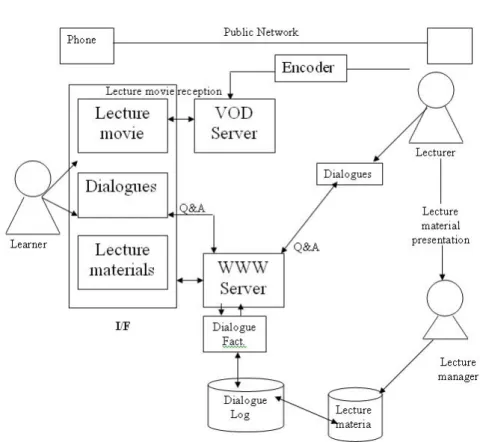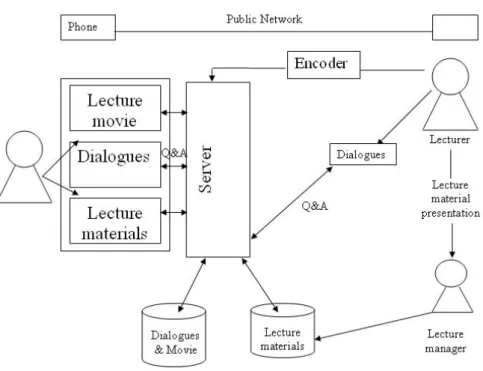Prof.Dr.Yehia A. El-Mashad
Dean of Delta Academy of science Mansoura, Egypt ymashad@hotmail.com
Eng.Mohamed Abd Elhamid Abbas
Delta Higher Institute of Computers Mansoura, Egypt mohaym_2000@yahoo.com
MODIFYING THE E-LEARNING LECTURE ENVIRONMENT STRUCTURE
Abstract
Today, educational technologies are reaching a state that allows inter-operability and the reuse of learning resources. The underlying techniques rely heavily on standards movements for metadata representation. In this paper, a learning frame- work where services can be developed and exchanged – as well as within systems – is suggested.
Metadata is not viewed as an objective to be downloaded from some central server but as subjective utilizations of resources that are distributed and shared in different contexts. This can evolve dynamically and it can be done by using one server and two databases located on such a server; one for the courses content and the second for storing the video of the lecturer after streaming.
Introduction
In e-learning many features are important for learning such as courses materials, video and sound - and such features can see summarized in the distance lecture envi- ronment structure. This structure consists of a VOD server, a www server, course materials, and a public network making a connection between a lecturer and the learner.
The transmission function of a lecture’s film and sound content: the film and sound information from a lecture is distributed to the attending sites via the VOD server real-time transmission function and a dedicated Proxy server is used to relay the distribution of lecture film and sound between Internet sites to the ensure good data reception. Learners at far sites will attend lectures’ by viewing the lecture film and sound data distributed by the VOD server.
Lecture material presentation function: the lecture materials are formatted as HTML sources and offered to students via the WWW server. Students use the WWW browser to access the lecture materials and to follow the lecture progress by referring to the appropriate page.
Dialogue (chat) function: a CGI (Common Gateway Interface) program written in Perl (Practical Extraction and Report Language) ensures communication between lecturer and learner. Lecturer and learners access the CGI program via the WWW browser and perform a question and answer (Q&A) session via the chat terminal screen. [1]
This paper recommends a new structure for the Distance lecture environment:
using one server instead of the two servers (VOD, www), using two databases locat- ed on the one server, one database for the course materials and the second for storing the video of the lecturer and the dialogue. Especially due to the increasing network traffic, students cannot follow the lecturer due to delays in the network, - so the video database will give students the chance to see the lecture completely, at in any time. This new structure increases the performance of the interactive e-learning system and also lowers the costs.
The distance lecture environment structure
This section presents the existing distance lecture environment structure, which consists mainly of the VOD server, the WWW server and a public network. Figure 1 shows the structure of the distance lecture environment [1]. It shows us that the system of distance learning starts from the lecture, where there is a camera that sends the lecturer’s image via film through an encoder to a VOD server, which sends the lecture movie to the learner through a network. The Dialogues between the lecturer and the student are sent through a web server that has a quality assurance level to ensure the quality of sounds. The lecture materials are transferred to a data- base by the lecture “manager” in the web server. Finally the lecture materials are sent to the learner.
This design suffers from some problems - such as, when traffic is increasing in the network students cannot follow the lecturer due to delays in the network – i.e.
where the sound may not match the image in the video, or the sound may not be crisp- which in many cases, might cause the lecture to fail.
So, it is very important to find a way for this system to overcomes these prob- lems and to increase the performance of the system while also minimizing the costs.
The next section presents a new view of the Distance lecture environment struc- ture.
Enhancements in distance lecture environment structure
Figure 2 presents a new perspective of the distance lecture environment structure so that it overcomes the problems mentioned in the previous section. This design depends on the concept of two databases being located on one server, one database for the course materials and the second for storing the video of the lecture and the dialogues.
Figure 1: The distance lecture environment structure
The lecturer’s Dialogue is sent to the server which sends it through the network to the learner, and it is stored in a database; also the films is sent through the encoder to the server, and the server sends it to the learner, while a copy of the films is stored in the same database as the dialogues
Technologies suitable for the enhanced distance lecture environment structure
There are many existing technologies which are suitable for the enhanced struc- ture such as the Multimedia Database and High-speed networks. These technologies give the new structure the power to do its job via increasing the performance poten- tial of the system. This section explains their importance in the enhanced distance lecture environment structure.
Figure 2: Enhancements in the distance lecture environment structure
1 Multimedia Database
Many research projects have mentioned the concept of a multimedia database [2, 3, 4, 5, 6].
E-learning is available based on Intranet and Internet. Via such as activity, a dis- tributed multimedia database technique is needed. Multimedia presentations and courseware will be stored in the open database architecture and system, which is shared by instructors, students, and administrators of distance learning programs [2].
Research in multimedia database will be developed, and the concept of a hybrid multimedia database system. That has a hierarchical database statistics structure for both query optimization and reformulation analysis (without adding costs additional query processing cost) can be demonstrated in [3].
Other projects concentrate on the contents of the multimedia objects, where they may be queried from different perspectives, depending on the type of multimedia object. Thus, an object-oriented multimedia representation model can be presented, in [6].
multimedia are efficient; also, the storing of a lecture film and sound can occur dur- ing the delay in the network –and this allows a student to follow the lecture whnever he/she wishes.
2 High-speed networks
Some research concentrates itself in the area of high-speed networks and has made many efforts to increases its functionality [7, 8, 9]. In [7] H∞, a base controller, has been developed for rate feedback in a single bottleneck network. The rates can be assigned to the sources only after a certain transmission delay. [8] presents a pipelined heap manager that has been designed in the form of a core, being integra- table into ASIC’s. Pipelining the heap operations requires some modifications to the normal (software) heap algorithms. [9] describes the design and implementation of a distributed parallel storage system that uses high-speed ATM networks as a key element of the architecture. Other elements include a collection of network-based disk block servers, and an associated name server that provides some file system functionality. The implementation is based on user level software that runs on UNIX workstations. Both the architecture and the implementation are intended to provide for easy and economical scalability. This approach has yielded a data source that scales economically, at a very high speed. Target applications include on-line stor- age for both very large images and video sequences.
This research has shown that high-speed networks are important in the enhanced Distance lecture environment structure, and it is useful for transferring dialogues, films and course materials at high speeds to thereby retain synchronization between films and sounds and overcomes congestion in the network.
Conclusion
The current distance lecture environment structure includes many problems in its functionality, especially in a case of delays in the network.
This paper suggests a new structure for the distance lecture environment, one us- ing one server and two databases located on the only server, one database being for course materials and the second for storing the video of the lecturer and the dia- logues; and it is suggested that it processes a multimedia database which can service the operations of storing and querying using a high speed network.
References
1 “The Integrated e-Learning System-RAPSODY Based on the Distance Ecology Model and Its Practice”, Toshio Okamoto, Mizue Kayama, Hisayoshi In- oue and Alexandra I. Cristea.
2 “Distributed Multimedia Databases”, Timothy K. Shih Tamkang University, Tai- wan
3 “Facilitating Multimedia Database Exploration through Visual Interfaces and Perpetual Query Reformulations”, Wen-Syan Li K. Selquk Candant Kyoji
4 “Database Systems and WWW Applications Digital Libraries Multimedia Data- base Systems”, Earl F. Ecklund, Jr. 30 October 2002.
5 “VirtualMedia: Making Multimedia Database Systems Fit for World-wide Ac- cess”, Ulrich Marder University of Kaiserslautern
6 “MULTIMEDIA OBJECT MODELLING AND CONTENT-BASED QUERYING”, Anastasia Analyti, Stavros Christodoulakis , Multimedia Systems Institute of Crete (MUSIC)
7 “On Rate-Based Congestion Control in High Speed Networks: Design of an H1- based Flow Controller for a Single Bottleneck”, Hitay Ozbay, Shivkumar Kalyanaraman , Altug Iftar
8 “Pipelined Heap (Priority Queue) Management for Advanced Scheduling in High- Speed Networks”, Aggelos Ioannou and Manolis Katevenis
9 “Using High Speed Networks to Enable Distributed Parallel Image Server Sys- tems” Brian L. Tierney, William E. Johnston1, Hanan Herzog, Gary Hoo, Guojun Jin, Jason Lee, Ling Tony Chen, Doron Rotem

